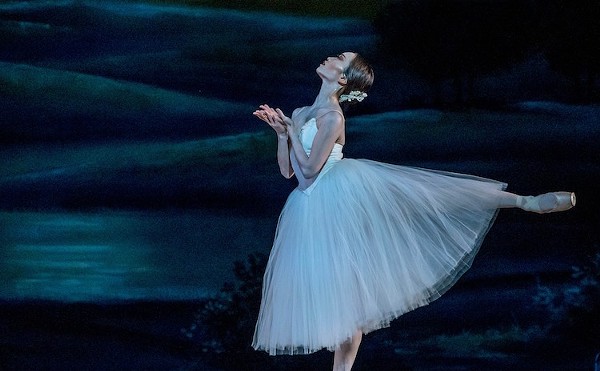Very happy ending
; All's Well That Ends Well
; Orlando Shakspeare Theater
; 812 E. Rollins St.
; 407-447-1700
; www.orlandoshakes.org
; $20-$38
The director's challenge when mounting a Shakespearean comedy, especially an arcane and wordy one like All's Well That Ends Well, is to set up the scenes from start to finish, know how and where to ask for laughs, let the actors loose and trust that even if the audience cannot fathom all the archaic references and complex verse, they will still get the gist of the action. And even if it takes a little schtick once in a while to move things along, well, all's well that ends well.
Orlando Shakespeare Theater's artistic director, Jim Helsinger, playing at the top of his game, admirably delivers all these comic goods and more in the company's current production. He renders a delightful and surprisingly full-blooded version of the Bard's romantic fantasy – a play that, in lesser hands, would have petered out long before its predictably joyous finale.
The plot of All's Well is all fantastical fairy tale: Helena, a lovely servant girl, has fallen hopelessly in love with an aristrocrat, Bertram, the son of her noble mistress, the Countess of Rousillon. When the object of her affection embarks for Paris to embrace mentorship by the King of France, Helena decides to follow, hoping by hook or crook to win Bertram's hand in exchange for curing the ailing French king's "fistula" with medicines left to her by her doctor father. The only hitch in her plans was not foreseeing that Bertram might refuse, but under extreme duress, the marriage is performed if not consummated.
Prodded by his oily servant, Parolles, unhappy Bertram leaves his shell of a bride and goes off to fight the wars, while Helena and her countess mother-in-law conspire to force a happier ending. And though it does take more than two and a half hours to finally get there, Helsinger and his proficient band of players make the antic journey both funny and moving, combining broad comedy with vibrant and emotionally charged characterizations.
Marni Penning is radiant as Helena; Eric Zivot, perfect as the sly braggart, Parolles; Steve Hendrickson's portrayal of the king is powerful and poignant; and Brandon Roberts, as Lavatche the clown, and Anne Hering, as the countess, successfully bear much of the heavy comic lifting. Stafford Clark-Price's Bertram could probably use more rambunctious attitude; the stronger his childish defiance and immature self-regard, the greater his redemption and growth can be by the play's end.
— Al Krulick
Haunting highlands
; Alba – Paintings of Scotland
; Through March 13 at Neu America Art Gallery at CityArts Factory
;29 S. Orange Ave.
;321-948-8310
;www.cody-rapport.com
A landscape is one thing; landscape as theming for darker forces is entirely another. Local painter Allan Cody-Rapport, the artist of the month at the relatively new Neu America Art Gallery, displays his latest series, this time based on the mythic mists of Scotland, into which he projects a spiritual essence informed by the romantic lore.
Cody-Rapport's soft expressionism contains a fury of archaic Pict mythology, which is presented in a consistent intensity and imbues his work with a dramatic mysticism. Mostly traditional perspectives are painted in deep, brooding colors; compelling black forms define their composition and are enhanced sometimes by drawing ("Landscape IV") or by embedded rectangles of flat, rusted metal.
In "Hora Mortis," a moonlit tree seems strangely tormented. The title is ancient Latin for "hour of our death" and leaves an echo of the closing words of the "Hail Mary" prayer ("now, and at the hour of our death"); the moonlight throws a thick and heavy burden over the skeletal subject, positioned in a religious context.
In "Strontian," we see not the western Scottish village itself, but rather a backlit path traversing up a hill through the woods. Cody-Rapport's sensibilities steep this innocent scene with the ominous portent of mythological gods. The shadowless forest climbs up, with a detail of disturbing vertical lines on the left, a weak light behind the trees and the lower right foreground vignetted into the warm blackness of asphaltum.
This sort of forced farsightedness enhances the dreamlike quality of his paintings. In all of Cody-Rapport's Alba (the medieval Gaelic name for Scotland) series, the heaviness is almost overwhelming, seeping into skies and surfaces. Works like "Ardtoe," (a seaside village on the west coast of the country with receding lakes and marshes framed in black mountains) glower and grumble, a sharp splatter and scratch in the foreground hinting at vehemence and Macbeth-like revenge boiling under the surface.
The uniform quality of these paintings, the artist's self-consciously placed signatures and notes made directly on canvas dispel some of their emotional power. One longs to see this artist more out of control, less brand-conscious and truly driven to dig into the spiritual forces only hinted at in these exquisite paintings. As it is, they simmer and bubble slickly with timeless legends told through landscapes.
— Richard Reep
;; [email protected]














